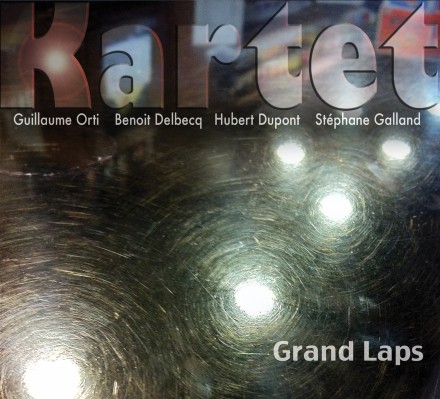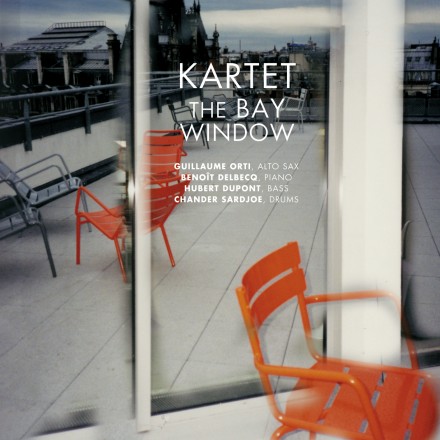Kartet
Grand Laps
SGL1605-2“Kartet makes a deliberate and beautiful brand of inside-out jazz…decidedly unconventional yet not harsh or taxing on the ear…Kartet flows seamlessly in and out of improvisations, and its arranged material shows harmonic daring and imagination.”
– Will Layman, PopMatters (reviewing The Bay Window)
It’s seven years since Kartet’s sixth album The Bay Window (Songlines), but then this is a group that’s been pacing itself for the long haul. Celebrating its 25th anniversary in 2014, Kartet retains its unique sound and approach while introducing some new elements – Belgian drummer Stéphane Galland (Aka Moon, Zawinul Syndicate) replaces Chander Sardjoe, and C-Melody and F mezzo-soprano saxes supplement Guillaume Orti’s alto sax. The album title by the way is a bi-lingual pun: in French, grands laps means “a long while”. And the band’s name? According to pianist/recording supervisor Delbecq, “The letter K was a nod to Eastern European cultures and of course to Bela Bartok and his extraordinary imaginary folklore researches.”
What makes Kartet special has perhaps best been described by the French critic Stéphane Ollivier: “…music in continuous metamorphosis as it pivots around the four players, and results in many simultaneous and complementary points of view on the same reality…a music which reconciles intellect and intuition as it combines a quasi-mathematical rigour with a sensitivity, an instrumental originality, and an attention to detail forged by the supreme exercise of total improvisation.” Hubert Dupont explains how the group develops new pieces: “The improvisations are very connected to the written material indeed, which is quite dense most of the time, with rhythmic games, melodic rules, colours, etc. It’s just jazz! New compositions hopefully sound good and allow for all kinds of atmospheres, but they [also] contain the rules of the game for the collective improvisation. To make a good piece, the rules should be simple enough, but somehow different. We enjoy playgrounds, frames, in order to spontaneously organize together tension / resolution movements, suspended colours, illusions… it’s a very funny game, with different results every time, it’s exciting…We definitely remain surprising for each other – the suspense never ends, like, “What is he gonna do after THAT?”
Orti adds: “[Our compositions] work with strict and limited harmonic-melodic material, strongly connected with the rhythmic material. But the shapes we can give to our melodic and rhythmic wanderings are unlimited… I personally try to bring interactive combinations that are somehow new for the band – what new playable situation can I ask my partners to take on? Strangely enough, I do have the impression we’ve always been playing about the same kind of music since the beginnings, but that originality, interplay, communication, etc. get more subtle and stronger with time.” Delbecq expands on his own process: “For myself, any new rhythmic material is worth sitting down at the piano with, or tapping or juggling with, to enter into a specific knowledge of it. Imagination is like a muscle, and if you give it new ideas it can lead you to unexpected territories, which is what I’m looking for, because that’s when the body ends up speaking first, the flow being given by the trained mind, ready to react like a spring.”
And the effect on younger musicians, and on the audience? “We’ve been – and still are I think to a certain extent – a source of inspiration. Usually, the people who are passionate about Kartet also dig musicians like Steve Coleman, Steve Lehman, Andy Milne, Ralph Alessi, Tyshawn Sorey, Craig Taborn, Tim Berne… to name a few greats who are constantly searching for newer shapes, a mixture of control and freedom. [Yet] there are not that many bands on the scene that really experiment with these kinds of forms. We might be considered as living in an enclave but I consider that a ransom for creativity. Our music is not docile, it doesn’t answer a market demand or anything, it is music that’s sincere in its primary direction: find a collective sound, develop our own way to play and build music in a collective way, bring the listener into a state of dream, of trance. That’s what the audience receives when they attend our concerts, there is some magic going on.”
For more information: hubertdupont.com, delbecq.net, guillaumeorti.com, stephanegalland.com.
View the making-of video here.

